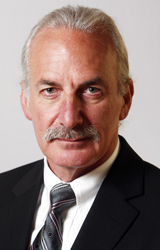Feynman’s Vision
by Donald Eigler
The co-chairs of the “Plenty of Room in the Middle” symposium reflect on the celebrated physicist’s role in the narrative of nanoscience.

The Authors

Feynman was already a celebrated scientist when he gave the talk. His reputation continued to grow afterwards -- but not because of “Room at the Bottom” or its ideas. Feynman’s inquisitive mind took him mainly in other directions (he shared the 1965 Nobel Prize for the discovery of quantum electrodynamics), and he rarely returned to the subject of nanoscience. He spoke on the topic at Jet Propulsion Laboratory in 1983, but the transcript of that talk was not published until 1993, five years after his death.
The fame of “Room at the Bottom” did not really take off until the 1990s. Nanoscience was well under way by then, spurred by inventions such as scanning tunneling microscopy (STM) and by the constant pressure in computing to get more and more processing and storage capacity out of less and less space.
But if Feynman did not start this revolution, he foretold it in remarkably accurate detail.
“It took 45 years before technology caught up with the dreams that he had,” states Michael Roukes, co-chair of the Kavli Nanoscience Institute at the California Institute of Technology.
Michael Roukes, a physicist developing nanoscale tools for bioscience and medicine, says “Room at the Bottom” anticipated a host of important technologies and scientific fields, including spin electronics (“spintronics”), microelectromechanical systems (MEMS), electron-beam and ion-beam fabrication and much more. Roukes says researchers learned about “the granularity of nature at the nanoscale,” where processes that are continuous at larger sales (such as electrical and heat conductance) are no longer so, and “quantum effects become dramatically manifest.”
And this wasn’t just any scientist speculating about a new frontier. “Without a doubt, Feynman is regarded as not just a demigod but a fully-blown god of physics,” says Don Eigler, the IBM researcher who in 1989 realized a key element of Feynman’s vision by spelling out the letters “IBM” with individual xenon atoms.

Eigler met Feynman just once – as a post-doc at Bell Laboratories, when Feynman paid a visit to the STM lab there. But he says he felt a “tremendous affinity” with the physicist “as a result of going back and reading ‘There’s Plenty of Room’ at a point in my career where I could recognize that what I had done in my research was to achieve what he had laid out in goals … We all like to feel close to the gods.”
So it’s no surprise that, when Roukes and Eigler organized the upcoming Kavli Futures Symposium on the future of nanoscience, they looked to Feynman for their theme. The symposium’s title, “Plenty of Room in the Middle: Nanoscience – The Next 50 Years” pays homage to the man who delivered “Room at the Bottom” while suggesting the need for an updated vision – to scale up from the atomic level to “systems and structures” that can meet real-world needs.
The event embodies another Feynman trait, that of wide-ranging inquiry. Its roster of session leaders and other participants shows just how wide the nanoscience stream has become. It draws on some of the world’s most prominent figures in quantum physics, chemistry, biology and materials science. It has potential for applications in medicine, computing, energy and beyond. Can the symposium match Feynman’s feat of scoping out the future several decades ahead? Probably not, Roukes says. What he calls “showstoppers” -- breakthroughs in technology that change the course of both technology and science – are too hard to predict. And that makes Feynman look even more remarkable. As Roukes points out, “It took 45 years before technology caught up with the dreams that he had.”